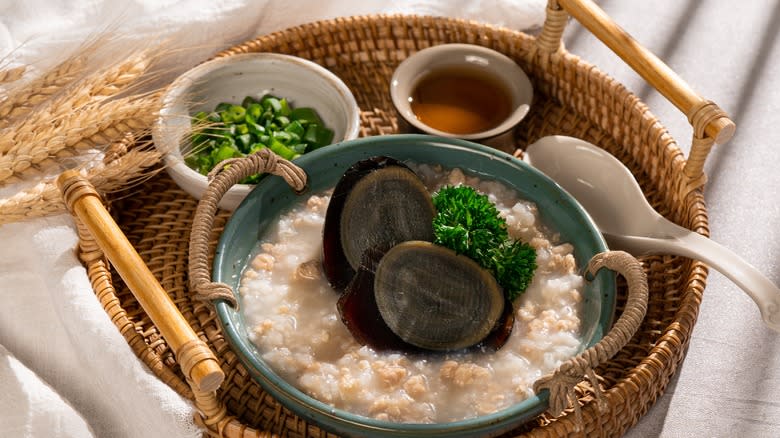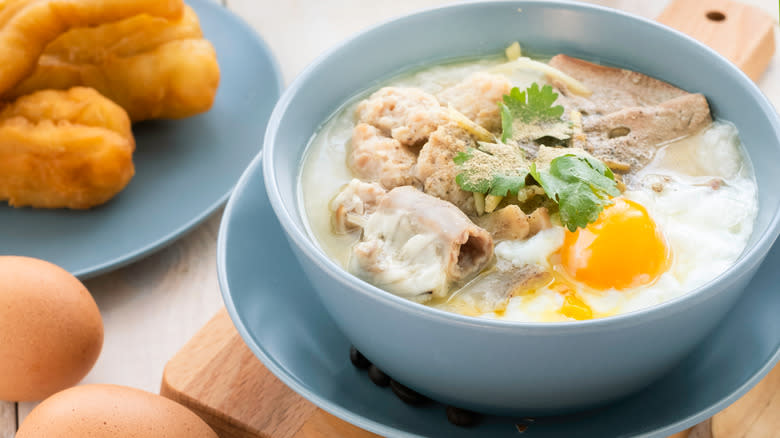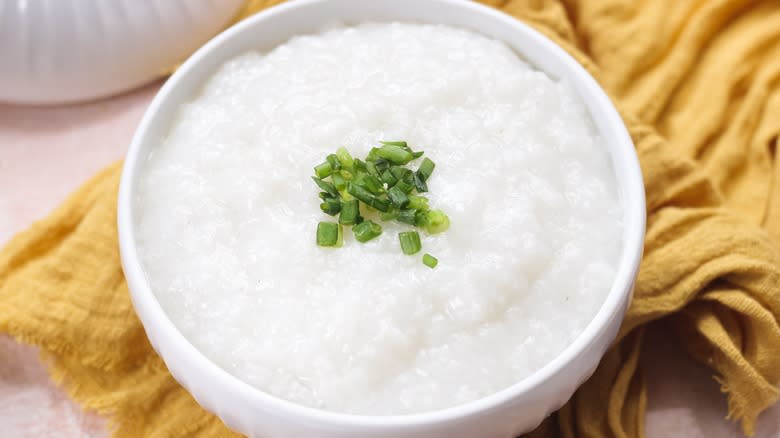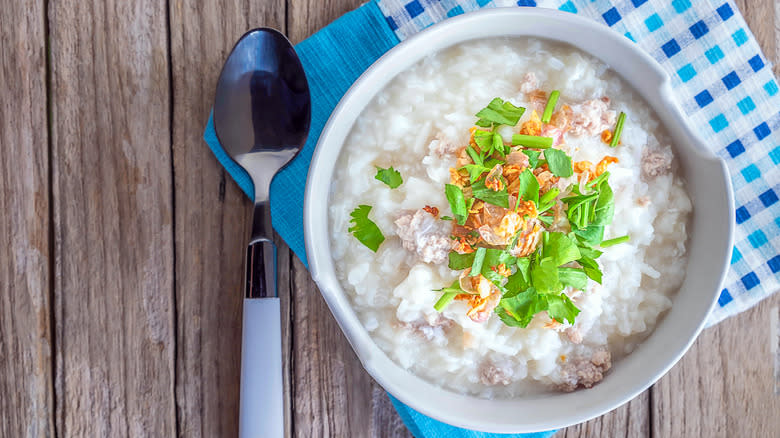Congee Is The Traditional Chinese Rice Dish With A Variety Of Flavor Choices

- Oops!Something went wrong.Please try again later.
When an unfortunate bout of illness strikes, a comforting and restorative meal pays off manifold. In the U.S., chicken noodle soup or simply a mug of bone broth are frequent go-tos. Meanwhile, in Asia — especially China — a bowl of steaming congee evokes similar restorative affiliations.
It's easy to see why: The dish is remarkably straightforward in its essence. Grains of rice are slowly cooked and deconstructed from their husk, creating a thick, satiating, and warm porridge. It's also easily topped with a wide variety of aromatic additions or folded in with poultry, meat, and seafood, so taking personal tastes into account is a breeze. Perhaps it's no surprise, then, that such a simple and easily moldable dish has endured for hundreds — if not thousands — of years. Popular all around Asia, it emerged in China, where it continues to be an especially popular comfort food. So what is traditional Chinese congee, and what makes it distinct? It turns out that this one dish encompasses a whole lot of possibilities.
Read more: 21 Delicious Ways To Use Up Leftover Rice
Chinese Congee Has Served As A Comforting Meal For Centuries

Congee has been enjoyed for centuries — while records note its presence during the Han dynasty in China (roughly 206 B.C. to 220 A.D.), some research suggests it may even have emerged as early as 1,000 B.C. during the Zhou dynasty. From there, it spread throughout Asia, where it's known by many names — in fact, "congee" itself stems from the Tamil word "kanji," later transcribed to "canje" by Portuguese botanist Garcia de Orta. In China, it's referred to by an entire array of regional terms, including "jūk" in Cantonese, "zhōu" in Mandarin, and "muay" in Hokkien and Tuachay.
As a result of its widespread nature, congee is enjoyed in a variety of settings and preparations. In many parts of China, it's an especially popular breakfast dish, served alongside a range of sides. Esteemed for its comforting, easily digestible nature, it's also commonly served during sickness, oftentimes strengthened with ginger. And due to its satiating, cost-effective nature, it's a dish historically intertwined with times of famine, war, and economic hardship. No wonder it has not only endured but also continually sustained in popularity.
What's In Chinese Congee?

Chinese congee — especially the ever-popular jūk version — is frequently made with white rice; however, it can utilize a wide range of grains. In Northern China, where rice doesn't grow as readily, it's crafted with everything from corn, barley, or wheat to sorghum, millet, or tapioca. Congee preparation is simple, with the grain cooked in varying types of stock or water.
The dish's elaboration is all in the garnish. Simple toppings include sliced scallion, soy sauce, and sesame oil. Alternatively, congee can be elevated to a more involved pi dan zhou with minced pork and century eggs. Another classic combination comes together with marinated chicken, shiitake mushrooms, peanuts, and scallions. And the integrated protein isn't limited to land critters — a popular Cantonese congee is made with a white, flaky fish flavored with Shaoxing wine, oyster sauce, and white pepper.
Due to congee's therapeutic affiliation, the dish also frequently integrates medicinal ingredients. Fuzhou-born Laba congee, which is traditionally enjoyed according to the lunar calendar, employs whole grains, nuts, and dried fruit. Congee in Yunnan is crafted with black rice and Job's tear, a grain full of calcium, iron, zinc, protein, and antioxidants (via Science Direct). Such malleability is a cornerstone quality of the dish — a variance that extends abroad, too.
How Does Chinese Congee Differ From Other Varieties?

Due to congee's abundant regional variations, the Chinese-born porridge doesn't boast one distinct style. Apart from the frequent use of ginger and scallions and a typically thick resultant texture, preparations aren't singular. Instead, other Asian cuisines feature renditions of congee prepared with local ingredients. In Korea, where the dish is known as juk, grain-based congees are common, topped with beans, sesame seeds, nuts, and sweeter additions like pumpkin.
Meanwhile, in Thailand, congee preparations tend to be much more soupy than Chinese renditions, flavored with a hefty dose of garlic and ginger and served with pork and shrimp. Congee is popular all around the Indian subcontinent, too; crafted with mixed grains such as rice and lentils, it's often served with mung bean sprouts and flavored with spices like turmeric and ginger, then finished with mustard oil. And due to a Portuguese colonial history in Asia, a variation of congee is also enjoyed in areas of the Western world — similar to a chicken and rice soup, the dish known as canja de galinha is popular in both Brazil and Portugal. Such is congee's appeal: As a basic, comforting grain porridge, it can easily adapt to whatever food is on hand, no matter where in the world you may be.
Read the original article on Tasting Table.

